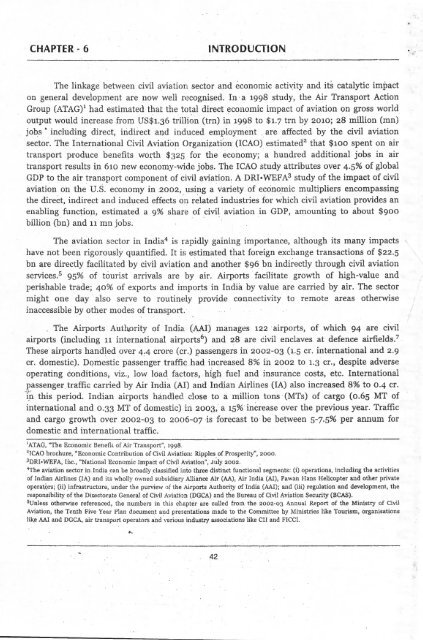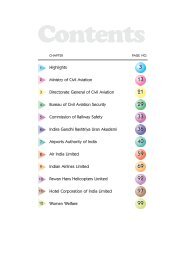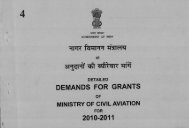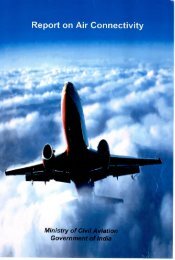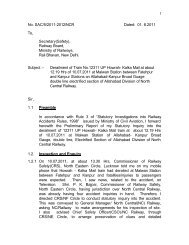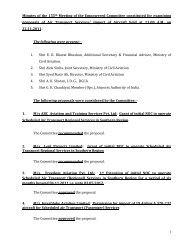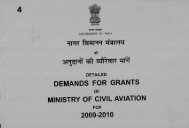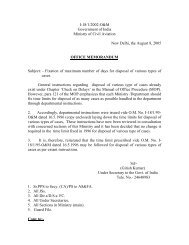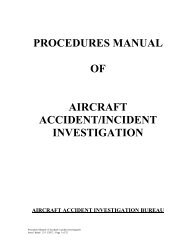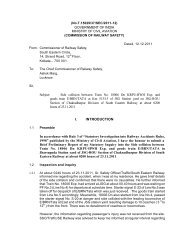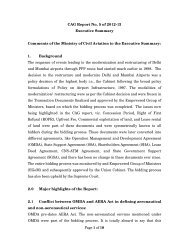3 - Ministry of Civil Aviation
3 - Ministry of Civil Aviation
3 - Ministry of Civil Aviation
You also want an ePaper? Increase the reach of your titles
YUMPU automatically turns print PDFs into web optimized ePapers that Google loves.
CHAPTER - 6INTRODUCTIONThe linkage between civil aviation sector and economic activity and its catalytic impacton general development are now well recognised. In. a 1998 study, the Air Transport ActionGroup (ATAG)' had estimated that the total direct economic impact <strong>of</strong> aviation on gross worldoutput would increase from US$1.36 trillion (trn) in 1998 to $1.7 trn by 2010; 28 million (mn)jobs including direct, indirect and induced employment are affected by the civil aviationsector. The International <strong>Civil</strong> <strong>Aviation</strong> Organization (ICAO) estimated' that $100 spent on airtransport produce benefits worth $325 for the economy; a hundred additional jobs in airtransport results in 610 new economy-wide jobs. The ICAO study attributes over 4.5% <strong>of</strong> globalGDP to the air transport component <strong>of</strong> civil aviation. A DRI•WEFA 3 study <strong>of</strong> the impact <strong>of</strong> civilaviation on the U.S. economy in 2002,using a variety, <strong>of</strong> economic multipliers encompassingthe direct, indirect and induced effects on related industries for which civil aviation provides anenabling function, estimated a 9% share <strong>of</strong> civil aviation in GDP, amounting to about $900billion (bn) and 11 mn jobs.The aviation sector in India 4 is rapidly gaining importance, although its many impactshave not been rigorously quantified. It is estimated that foreign exchange transactions <strong>of</strong> $22.5bn are directly facilitated by civil aviation and another $96 bn indirectly through civil aviationservices. 5 95% <strong>of</strong> tourist arrivals are by air. Airports facilitate growth <strong>of</strong> high-value andperishable trade; 40% <strong>of</strong> exports and imports in India by value are carried by air. The sectormight one day also serve to routinely provide connectivity to remote areas otherwiseinaccessible by other modes <strong>of</strong> transport.. The Airports Authority <strong>of</strong> India (AAI) manages 122 airports, <strong>of</strong> which 94 are civilairports (including 11 international airports 6) and 28 are civil enclaves at defence airfields.?These airports handled over 4.4 crore (cr.) passengers in 2002-03 (1.5 cr. international and 2.9cr. domestic). Domestic passenger traffic had increased 8% in 2002 to 1.3 cr., despite adverseoperating conditions, viz., low load factors, high fuel and insurance costs, etc. Internationalpassenger traffic carried by Air India (Al) and Indian Airlines (IA) also increased 8% to 0.4 cr.in this period. Indian airports handled close to a million tons (MTs) <strong>of</strong> cargo (0.65 MT <strong>of</strong>international and 0.33 MT <strong>of</strong> domestic) in 2003; a 15% increase over the previous year. Trafficand cargo growth over 2002-03 to 2006-07 is forecast to be between 5-7.5% per annum fordomestic and international traffic.'ATAQ, "The Economic Benefit <strong>of</strong> Air Transport", 1998.'ICAO brochure, "Economic Contribution <strong>of</strong> <strong>Civil</strong> <strong>Aviation</strong>: Ripples <strong>of</strong> Prosperity", 2000.3DRI•WEFA, Inc., "National Economic Impact <strong>of</strong> <strong>Civil</strong> <strong>Aviation</strong>", July 2002.•"The aviation sector in.India can be broadly classified into three distinct functional segments: (i) operations, including the activities<strong>of</strong> Indian Airlines (IA) and its wholly owned subsidiary Alliance Mr (AA), Air India (AI), Pawan Hans Helicopter and other privateoperatOrs; (ii) infrastructure, under the purview <strong>of</strong> the Airports Authority <strong>of</strong> India (AAI); and (iii) regulation and development, theresponsibility <strong>of</strong> the Directorate General <strong>of</strong> <strong>Civil</strong> <strong>Aviation</strong> (DGCA) and the Bureau <strong>of</strong> <strong>Civil</strong> <strong>Aviation</strong> Security (BCAS).sunless otherwise referenced, the numbers in this chapter are culled froth the 2002-03 Annual Report <strong>of</strong> the <strong>Ministry</strong> <strong>of</strong> <strong>Civil</strong><strong>Aviation</strong>, the Tenth Five Year Plan document and presentations made to the Committee by Ministries like Tourism, organisationslike AAI and DGCA, air transport operators and various industry associations like CU and FICCI.ti42


